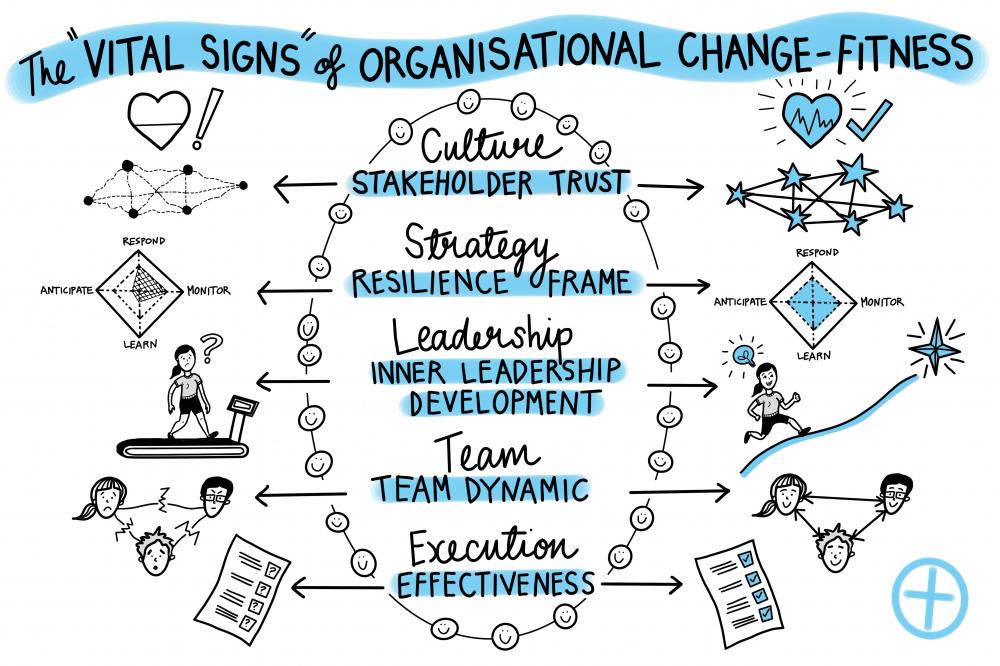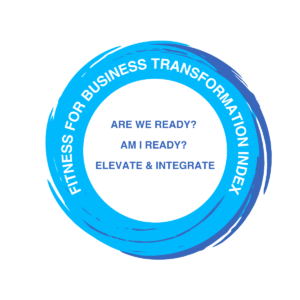Leadership team change-fitness is the critical enabler in tackling new strategic imperatives
In my work in organisational transformation executive leader’s talk is often focused on the classic phases of strategy development.
References such as John Kotter’s 1995 8 Steps as outlined in Leading Change: Why Transformation Efforts Fail (1) is still a classic for many senior leaders.
(Interestingly Kotter has revised and updated his own views acknowledging the accelerated pace of change. A key refinement is: A “get to” mindset, not a “have to” mindset: People must feel they want to be change agents and have permission to do so. The energy associated with volunteers is essential and can only be utilized if people feel that this is something they ‘get to’ do rather than something they ‘have to’ do. (2)
As recently as January this year Boston Consulting Group state that 75% of transformations fail to deliver envisioned results and that “when we discuss change readiness with executives, the response is almost always anecdotal or intuitive”. Are You Ready to Transform? 06 JANUARY 2020 by Jens Jahn , Manuel Luiz , Reinhard Messenböck , and Robert Werner (3)
Talking with leaders about this phase, this pre-condition before we go about tackling a new strategic imperative. Before Strategy development and Strategy execution. Where recognising and confronting the gap (challenge or opportunity) that is to become a priority occurs. The criticality of the leadership team change-fitness as an enabler becomes evident.
This phase, along with strategy development and strategy execution requires the leadership to expose gaps of the business and it’s capability, explore the reality of the situation, expand their thinking and see alternative pathways, and have the energy to exert to see the phase through.
A leadership team looking to tackle the next strategic imperative would benefit by thinking like a sports team in preparation for a new competitive season that work on Match-fitness.
For high performing sportspeople and teams, getting match-fit includes holding themselves accountable, studying the developments in the game, addressing skills gaps, strengthening themselves, practising team drills, building team culture and receiving feed-forward on the practices of effective teams.[1]
Not being match-fit can result in brutal and often painful outcomes, and while being evident to all in the stands, there is nothing that can be done about this once the game is on. Balls will be dropped, players will be in the wrong spot for team flow, fatigue will show when the game is there to be won.
On the other hand, when a team is match-fit opportunities are presented, relationship bonds are strengthened, learning is accelerated, individuals grow and goals are scored. From the stands, viewers can sense the control; they marvel as players appear to anticipate moves and the game plan is executed with clarity.
Like a coach or sports trainer can assess aspects of fitness to determine Match-fitness, leaders can assess the vital signs of organisational change-fitness to determine their leadership team change-fitness.
Before getting in to Strategy Development or Strategy Execution we have a phase of Recognising and confronting the gap (challenge or opportunity).
The key question here is – What challenges and opportunities are we even seeing?
As an illustration, let’s do a brief scan of the Vital Signs of Organisational Change-fitness.
Weak stakeholder trust – missing inputs, both being shared and being received, about changing conditions and drivers of changing conditions.
Weak resilience frame – weak response to challenges and opportunities due to lack of monitoring of the changing signals in the current condition, resulting in lack of learning, and lack of anticipation resulting in no time to prepare. There are many inter-relationships between these four resilience capabilities. The lack of anticipation reduces learning, decreases likelihood to establish monitoring, leaving no time to respond when a challenge does become evident. Or to be more blunt we are blind-sided, and the articulate among us try to claim they were caught by a ‘Black Swan moment’.
Weak inner leadership development – the lack of an ‘At Cause’ mindset means we do not own the current circumstances and believe the power to change it is with others which removes our energy and focus from the challenge. The lack of a Growth mindset means we believe we fixed with our capabilities and may not even be up for confronting the challenge. Bias in our self-awareness could mean anything from we believe we have the capabilities required when clearly we don’t, through to not allowing ourselves to be open to other’s as people we can learn from.
Weak team dynamic – lack of ‘real’ conversations where there is robust challenge and build to set up team success. Where there is a lack of deep listening to understand a divergent view. Where there is a lack of goodwill to reconcile the different and sometimes weak signals that come with complexity.
The more we reflect on this topic it is not uncommon to become aware that many critical factors are out of view, consciousness, or focus for a busy leadership team.
This conversation brings to mind for me the phrase ‘Confront the Brutal Facts’ which Jim Collin’s research identified as a key step that differentiated organisation performance.
“There is nothing wrong with pursuing a vision for greatness. After all, the good to great companies also set out to create greatness. But, unlike the comparison companies continually refined the path to greatness with the brutal facts of reality.”
– Jim Collins, Good to Great
Larry Quick and David Platt in their book Disrupted: Strategy for Exponential Change explain the Strategy in Action process which is strategy development that considers the complex systems and interconnected systems we all live and work in as the world is increasingly connected and exponential trends can arise so quickly from many different angles.
Their first step is:
Reading, understanding and continually monitoring immediate and emergent conditions
(Emergent: In the process of coming into being or becoming prominent; arising as an effect of complex causes and not understood through analysis as the sum of the combined effects)
What are your experiences and insights around Match-fitness before a new strategy development phase?
Bernie
